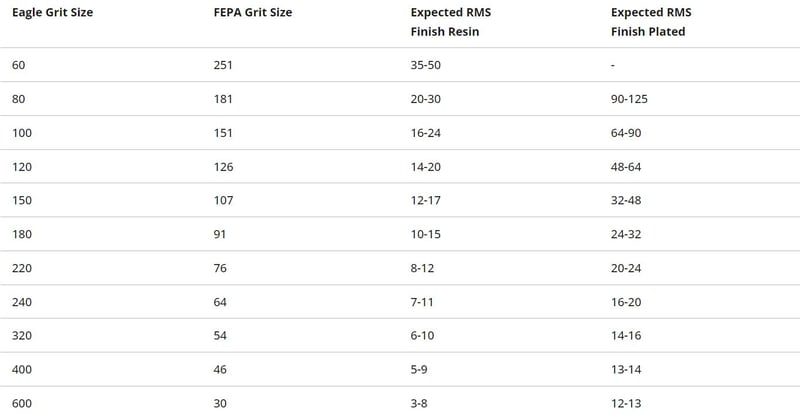A Guide to Choosing the Right Grit Size for Precision Grinding
In the realm of precision grinding, the choice of grit size in diamond and CBN (Cubic Boron Nitride) grinding wheels is critical for achieving the desired surface finish on a workpiece. Whether working with hard materials like carbide and tungsten carbide or honing high-speed steel (HSS), the right grit size can make a significant difference in both the efficiency of the grinding process and the quality of the finished product. This article explores the relationship between different grit sizes and the resulting surface finishes, providing insights into how to select the ideal grit for your specific grinding needs.

Understanding Grit Size
Grit size refers to the size of the abrasive particles embedded in the grinding wheel. It is a crucial factor that influences the wheel's cutting ability, stock removal rate, and the surface finish of the workpiece. Grit sizes are categorized into coarse, medium, and fine ranges. Coarse grits, with larger abrasive particles, are typically used for rapid material removal and rough grinding. Medium grits strike a balance between material removal rate and surface finish, while fine grits are used for achieving a smooth, high-quality surface finish.
Diamond and CBN Grits
Diamond and CBN are two of the hardest materials available for abrasive grinding wheels, known as superabrasives. Diamond wheels are optimal for grinding non-ferrous materials and hard, brittle materials like ceramics and carbide. CBN wheels, on the other hand, are ideal for ferrous materials, including HSS and tool steels. The selection between diamond and CBN grit depends on the material of the workpiece and the desired outcome of the grinding process. For example, grinding tungsten carbide typically requires a diamond wheel, while HSS is best ground with CBN.
This introduction sets the stage for an in-depth exploration of how grit size affects surface finish, with subsequent sections delving into specific grit types, surface finish requirements, and application-based grit selection. You can continue to build upon this foundation, integrating the graphical comparison of Ra and RMS with USA mesh and FEPA grit sizes, and discussing the various factors and considerations in selecting the appropriate grit size.
Surface Finish Requirements
Understanding surface finish is critical when selecting the right grit size for grinding. Surface finish refers to the texture and quality of the metal surface after grinding and is often measured in Ra (Roughness Average) and RMS (Root Mean Square) values. These values are inversely related to the grit size of the grinding wheel; finer grits result in lower Ra and RMS values, indicating a smoother surface. The forthcoming graphic will illustrate how different USA mesh and FEPA grit sizes correlate with specific Ra and RMS finish requirements, providing a practical guideline for selecting the appropriate wheels.
Factors Affecting Surface Finish
Several factors influence the surface finish achieved during grinding, including:
- Bond Type: The bond of the grinding wheel (resin bond, vitrified, etc.) affects its wear rate and cutting efficiency. Resin bonds, for instance, are known for their good surface finish and are often used with fine grits. Vitrified bonds offer a rigid structure ideal for precision grinding.
- Coolant Use: The choice between wet and dry grinding has a significant impact. Wet grinding, using a coolant, typically results in a better surface finish and longer wheel life due to reduced heat and friction. Dry grinding, without coolant, might be used for less heat-sensitive applications or where coolant is not feasible.
- Grinding Wheel Speed: High-speed grinding can lead to better finishes as it may prevent the wheel from loading up, but it also requires wheels designed to withstand the higher forces.
Grit Selection for Specific Applications
Choosing the right grit size is application-specific. For instance:
- Cylindrical Grinding and Centerless Grinding: Medium grits are usually employed to achieve a balance between material removal and surface finish.
- Honing and Fine Surface Grinding: Fine grits are necessary to achieve the high-quality finishes required in these applications.
- Coarse Grits for Roughing: When rapid material removal is the priority, such as in stock removal or shaping of a workpiece, coarse grits are the go-to choice.
Additional Considerations
In addition to grit size, other factors to consider include:
- Material Removal Rate (MRR): The speed at which material is removed from the workpiece. Higher MRR can be achieved with coarser grits but may sacrifice finish quality.
- Tolerances: Tighter tolerances might require finer grits to achieve the necessary precision.
- Dressing Tools: The condition of the wheel's surface is maintained by dressing tools, which can also impact the effectiveness of the grit.
- Micron Sizes for Superfinishing: In applications where ultra-fine finishes are required, micron-sized grits are used to achieve the necessary precision and smoothness.
![]()
Recent Posts
Subscribe to email updates
Subscribe to our blog to get the latest updates from the experts on Grinding Wheels! You can easily unsubscribe at any time




